How Do Wind Turbines Work? Components, Types & FAQ
-
Pete Ortiz
- Last updated:
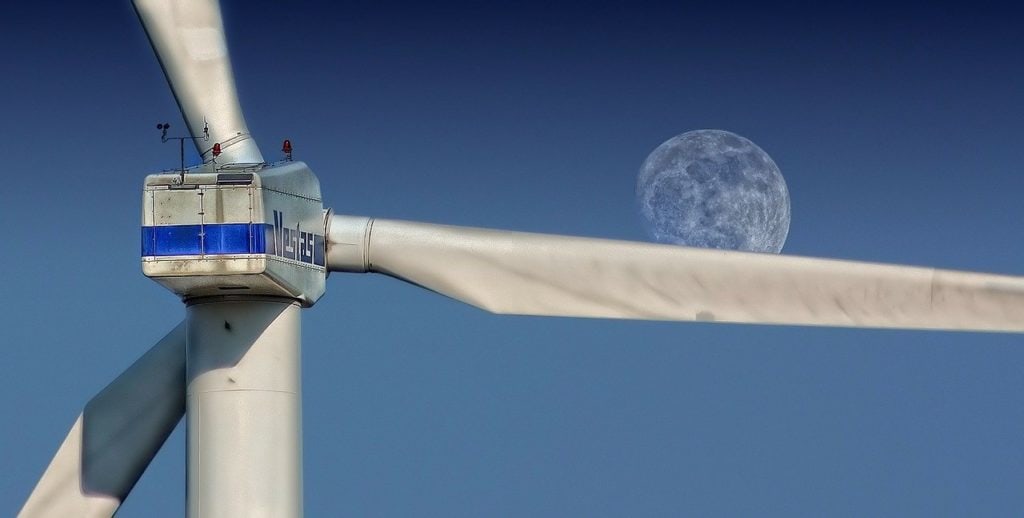
Our cities face the risk of blackouts now and then unless we do something to increase the electricity grid’s capacity. So, what’s the solution? Wind turbines it is!
Wind turbines are a fascinating source of renewable energy. They harness the power of wind and convert it into electricity. Man has harnessed wind energy for centuries, but modern wind turbines can generate more power with less fuss. Besides, wind power is a clean, low-cost, renewable energy source. It reduces our carbon footprint and contributes to a lower cost of living.
But how do wind turbines work? Here, we’ll discuss the components of a wind turbine and how they work to generate electricity. So, keep reading to learn more!
 Components of a Wind Turbine and How They Work
Components of a Wind Turbine and How They Work
The wind is a free energy source. Wind turbines are large spinning blades that capture the wind’s kinetic energy and turn it into mechanical energy. Then, the mechanical energy converts into electrical energy used to power homes and businesses.
Most wind turbines have three blades spinning around the rotor. As the blades spin, they are exposed to air currents, which pushes them around in a circular motion due to the Bernoulli Effect. This force makes the turbine rotate.
The rotor connects to the primary shaft and rotates a generator to produce electricity. Below, we explain how each component of a wind turbine works. This way, you’ll understand better.
1. Blades
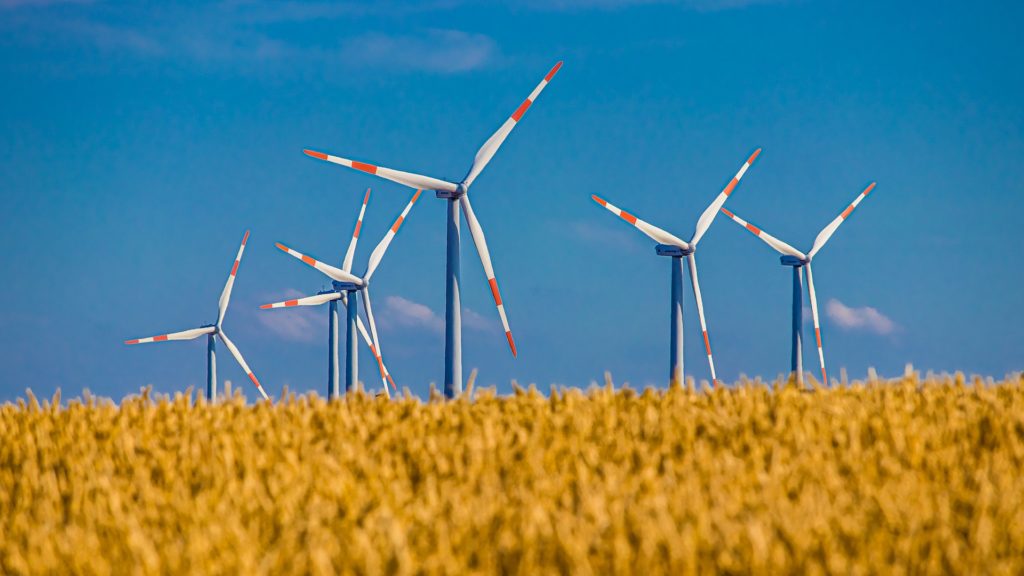
The blades make the wind turbines work. They are made of metal or composite materials and they’re attached to the rotor, which is connected to the bottom of the shaft.
They’re designed to catch as much wind as possible. They are angled in such a way that they rotate faster as the wind blows past them. It means they spin faster than they would if they were straight onto the wind. As the wind blows past them, they rotate and make the rotor spin.
2. The Rotor
The rotor is the spinning part of the turbine consisting of the hub, shaft, and the blades. As it rotates, the blades rotate and catch the wind, converting it into electricity. The hub is the center point at which all parts meet and attach. It also connects the blade to the rest of the turbine’s components through a shaft.
3. Low-Speed Shaft
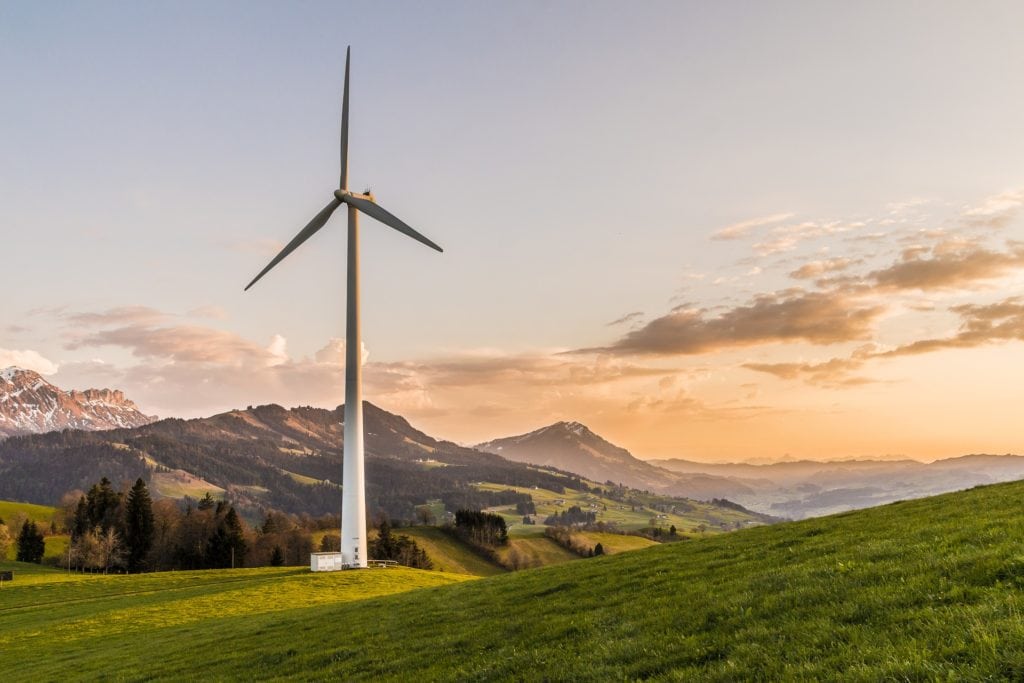
The low-speed shaft connects the rotor hub to the generator. Usually, its shaft is made of steel, and it’s hollow. This way, oil is pumped through it to cool internal bearings and gears.
Some turbines use an aluminum shaft instead of steel due to its lighter weight and lower cost. Besides, the low-speed shaft rotates at 30 to 60 rotations per minute (RPM).
4. Gear Box
The gear box connects the high-speed shaft to the low-speed shaft. Also, it increases torque (rotational force) from low to high RPMs. It uses gears that multiply torque.
The rotational speed increases from 30–60 RPM to 1,000–1,800 RPMs. It’s the speed at which many generators produce electricity.
5. High-Speed Shaft
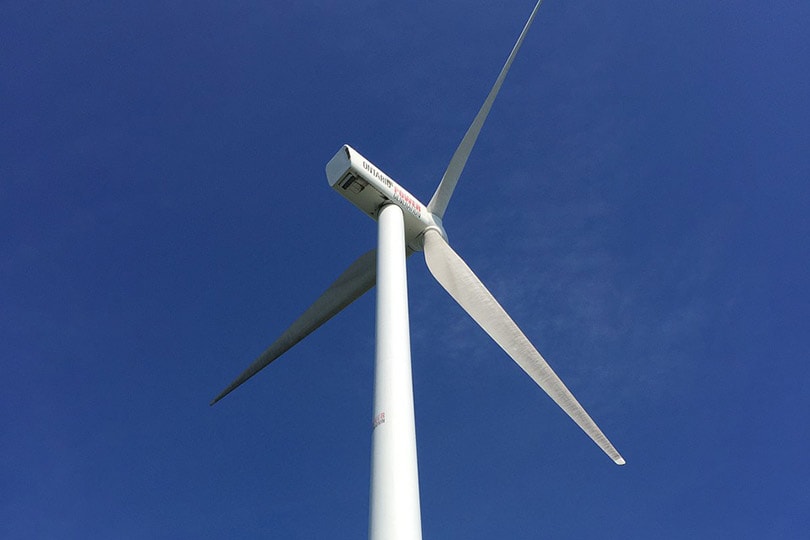
The high-speed shaft drives the generator and transmits power from the rotor to the generator at high speeds. It rotates with minimal vibration and friction, so it doesn’t interfere with the generator’s ability to convert mechanical energy into electricity.
6. Generator
The generator converts mechanical energy into electricity. It uses magnets and coils of wire, called a stator. It’s also arranged in a certain configuration so that when a coil moves past a magnet, it creates an electrical current in that coil.
The number of poles determines the number of coils that can pass through a single magnet. Three-pole generators are common on wind turbines. They allow for higher speeds than two-pole generators.
7. Anemometer and Controller
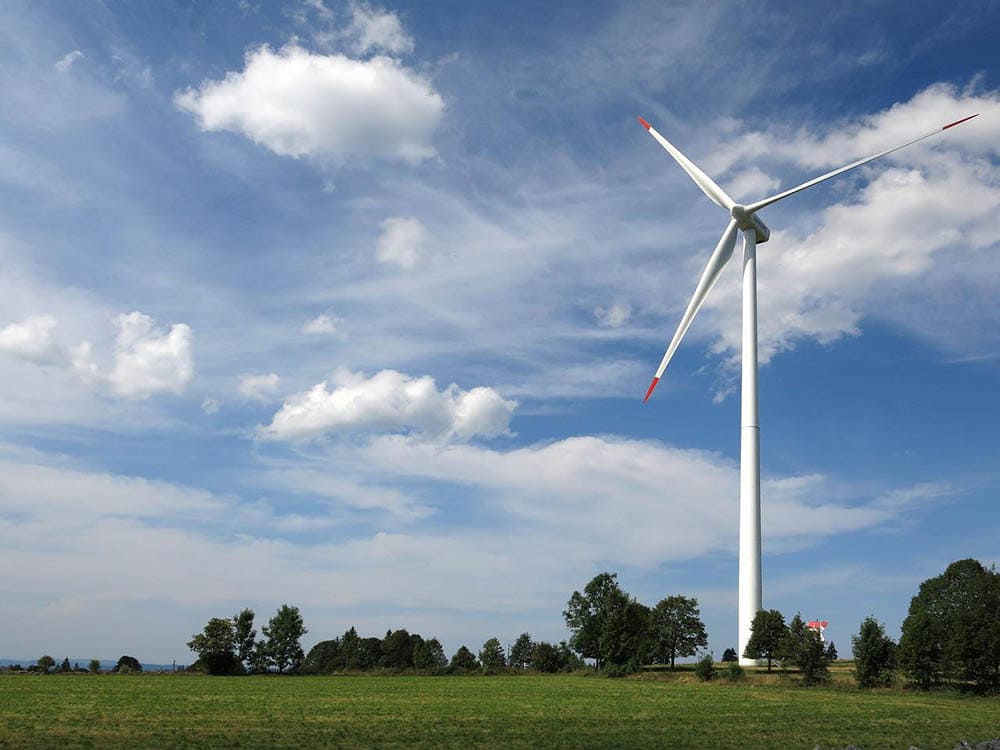
An anemometer sends speed data to the controller and measures the speed of the wind. On the flip side, it regulates the wind turbine’s speed.
The minimum speed of the wind turbine is between eight and 16 mph (miles per hour). The maximum speed is 55 mph. Wind turbines don’t exceed this speed as they may get damaged.
8. Pitch System
The pitch system is a crucial part of a wind turbine. It adjusts the angle at which the blades are facing and keeps them at a suitable angle for generating electricity.
9. Brake
The braking system stops the rotor in emergencies. It has mechanical brakes applied on the blades while electrical brakes are used on the generator shaft.
10. Wind Vane
The wind vane measures the direction of the wind. Also, it connects to the yaw drive. Together, they change the wind turbine’s direction, depending on the wind.
11. Motor and Yaw Drive
The yaw drive controls the direction of the rotor blades. It has a gearbox that changes the speed and direction of rotation. The motor powers the yaw drive.
12. Tower
The tower supports the wind turbine’s structure. It’s made of aluminum, concrete, or tubular steel. Usually, towers are built in a lattice structure with cross bracing. It provides rigidity and strength. Taller wind turbines capture more wind energy, thus leading to the production of more electricity.
13. Nacelle
This is the housing that holds the generator and other components of a wind turbine. It has two parts: the pylon (the tower on which it sits) and the hub (it contains the blades and the generator).
The nacelle is aerodynamic and lightweight. It rotates with little resistance. It also houses all the electrical wiring needed to connect the generator to the rest of your home or business’s electrical system.
What Are the Different Types of Wind Turbines?
Wind turbines are categorized according to their size and power output. There are many types of turbines. But the two most common designs are horizontal and vertical axes.
Here they are:
1. HAWTs (Horizontal-Axis Wind Turbines)
These are the most commonly used wind turbines. These turbines have three blades that rotate around a horizontal axle. Also, they’re attached to a gearbox that changes the rotational energy into electricity.
Horizontal-axis turbines may be placed on top of a pole, building, or tower. Besides, they can be mounted on the ground as part of a ground-mounted wind turbine system. In some cases, many wind turbines are used together to increase electricity generation.
- Reliable and efficient
- High power output
- High wind speed
- Challenging installation and maintenance
2. VAWTs (Vertical-Axis Wind Turbines)
This wind turbine rotates vertically around a central mast. It’s connected to an electric generator at the base. Usually, it’s used in low-wind areas, such as hilly areas where it’s challenging to build tall towers for horizontal-axis turbines.
Vertical-axis turbines are ideal for urban areas with limited space, and you don’t want a tall structure.
- Minimal maintenance needed
- Cheaper than HAWTs
- Functions in extreme weather conditions
- Operates quietly
- Produces less electricity compared to HAWTs
- Land-Based Wind Turbines: These wind turbines are anchored to the ground or mounted on towers and poles. They can be horizontal or vertical. They are used for commercial and residential applications. Most of the world’s wind power is generated by land-based turbines. Usually, they’re used in large clusters in areas with high winds. They also produce power for the national grid.
- Offshore Wind Turbines: Usually, offshore wind farms are located in coastal areas as there is less interference from buildings and trees. These turbines are attached to floating platforms in water about six miles offshore. This way, they don’t interfere with wildlife or ship traffic. They’re also massive and tall, so they generate vast amounts of energy.
- Distributed Wind Turbines: Distributed wind turbines are smaller and less expensive. They generate electricity at or near where the energy is needed. They can also generate net metering credits sold back to the utility company.
These wind turbines generate electricity for agricultural, residential, industrial, and small commercial applications.
Where Are Wind Turbines Used?
Wind turbines are used worldwide to generate electricity. You can find them in many locations from urban to rural areas on land or water. They can be grouped in wind farms to produce power for a utility grid.
- Urban Areas: Urban areas have little space for large-scale energy generation installations like wind turbines. But there’s still a lot of potential for wind energy in urban environments. For example, large buildings such as office blocks or apartment blocks with flat roofs, are ideal locations for small wind turbines. They can generate enough power to supply electricity for lighting and air conditioning systems.
- Rural Areas: Rural communities often use wind turbines as part of a larger scheme. They generate sustainable energy for their homes and businesses. Many rural communities are linked to national grids. It allows them to sell excess electricity back into these networks.
- Wind turbines use the wind to create a clean power source.
- The turbines can be erected on ranches and farms.
- Wind energy from wind turbines is sustainable.
- It’s also a renewable energy resource.
- Operating wind turbines is inexpensive.
- The wind energy industry creates employment.
- It’s a cheaper form of electricity.
- Wind turbines are noisy.
- They can impact the local wildlife, such as birds, negatively.
- Wind turbines are located away from large cities where the electricity produced is needed.
- Wind energy is unpredictable. The amount of electricity produced depends on the wind speed and direction.
- The turbines can interfere with the landscape’s visual appearance.
- It’s expensive to construct wind farms.
How Much Electricity Can a Wind Turbine Generate?
The amount of electricity generated by a wind turbine depends on several factors. One of them is wind speed. You must have enough wind blowing through the blades to turn them to produce electricity. If there isn’t enough wind, the blades will spin slowly, but no power is generated.
One onshore wind turbine can produce two to three megawatts (MW) of electricity. It can also generate above six million kilowatt-hours (kWh) of electricity annually. That’s sufficient electricity to power around 1,500 households.
Factors Affecting the Amount of Electricity Wind Turbines Generate
Wind turbines are efficient at converting wind energy into electricity. Several factors affect the amount of electricity wind turbines generate.
- Wind Speed: The higher the wind speed, the more electricity a wind turbine can generate. Usually, the average wind speed of a region determines whether a given area is suitable for wind power generation. But this can vary with time and space. So, it’s not a perfect indicator of how much electricity a turbine will produce at any moment.
- The Length of the Wind Season: The length of the wind season is another crucial factor affecting the electricity produced. Usually, longer windy seasons mean more electricity production because there must be enough steady winds throughout the year. This makes up for any lulls in production during periods when winds are light or non-existent for long periods such as during winter months.
- Diameter of the Rotating Blades: The electricity a turbine generates is proportional to the rotor’s diameter. The diameter determines how much air passes through it during each rotation. The higher the velocity of air molecules passing through a turbine’s blades, the more kinetic energy they have. Large rotor diameters increase efficiency, but they’re more expensive to install and maintain because they need strong foundations (base supports). They also need specialized materials like fiberglass or carbon fiber composite materials, which are lighter but still strong enough to withstand high winds.
- Pitch Control: Pitch control refers to how much angle is in the blades of a wind turbine. It depends on their rotation speed. It allows operators to increase or decrease power generation levels. They can adjust the blade pitch angles. It also depends on wind speeds and power output needs.
- Yaw Control: The yaw control changes the direction of a rotor blade angle during operation. This way, it’s always facing the wind. The feature also stops the blade from hitting obstructions such as trees or buildings which could reduce its performance and even cause damage or destruction to the equipment itself if not controlled well.
- The Efficiency of the Wind Turbine’s Components: Wind turbines are made of several components such as the blades, hub, and shaft. These parts must be well-engineered to withstand years of exposure to harsh weather conditions. The efficiency of each component depends on its design and the materials used in construction. For example, composite materials are used in blade construction. They offer better durability than metal or plastic blades.
Besides, they weigh less than metal blades, thus reducing stress on other components such as the gears.
Frequently Asked Questions
1. What Is the Ideal Location for a Wind Turbine?
The best location is on the highest point of a property, facing away. It’ll allow for maximum energy production. It also helps reduce noise pollution on the property.
Also, open fields and regions free from obstructions are ideal for wind turbines. Wind turbines should be placed away from trees and buildings. They should also be away from other objects that can cause turbulence and affect their performance.
2. What Country Leads in the Generation of Electricity from Wind Turbines?
China, the US, Germany, India, and Spain are the world’s top five wind-energy generating countries. China leads the pack in both total installed capacity and annual new installations. It also has an installed capacity of 221 GW (Gigawatts).
China also has the biggest onshore wind farm worldwide at 7,965 MW (megawatts). The United States comes in second with an installed capacity of 96.4 GW.
3. Why Are Wind Turbines, Pale Gray or White?
One of the reasons wind turbines are white is to reflect heat away from the blades and back into the atmosphere. It helps keep them cool and work efficiently. They also blend into the sky and avoid distracting aircraft.
White also makes the blades more visible to pilots. A pilot can see the turbine from a distance. The color of the blades may change over time as they wear out or under extreme weather conditions.
4. What Is the Ideal Wind Speed for a Wind Turbine to Work?
There are many ways to measure wind speed. The most common way is with anemometers. These instruments measure how fast the wind blows. They also count how many times a propeller spins inside them.
The faster the propeller spins, the more times it has counted per second. So, the higher the measured wind speed will be.
A wind turbine can start turning at a minimum speed of 12 to 14 km/h. Strong winds of 50 to 60 km/h can produce electricity at full capacity.
 In Conclusion
In Conclusion
Wind turbines are valuable additions to a country’s power grid and supply of renewable energy. They’re also efficient in turning the wind’s kinetic energy into electricity. It doesn’t take long to see a return on investment in wind turbines.
Many countries are considering using wind power. This way, they’ll move towards a cleaner, more sustainable future.
We hope you enjoyed learning how wind turbines work and what makes them tick. Also, we hope you now understand the facts and the intricate mechanisms that make wind turbines power our technological world. Now, you can feel more confident!
- How Do Wind Turbines Work?
- What are the Different Types of Wind Turbines?
- Categories of Wind Turbines
- Where are Wind Turbines Used?
- Advantages and Disadvantages of Wind Turbines
- How Much Electricity Can a Wind Turbine Generate?
- Factors Affecting the Amount of Electricity Wind Turbines Generate
- ALTERNATIVE ENERGY TUTORIALS
- LUVSIDE
- ARCADIA
- EVWIND
Featured Image Credit: Pixabay
Contents

 Components of a Wind Turbine and How They Work
Components of a Wind Turbine and How They Work